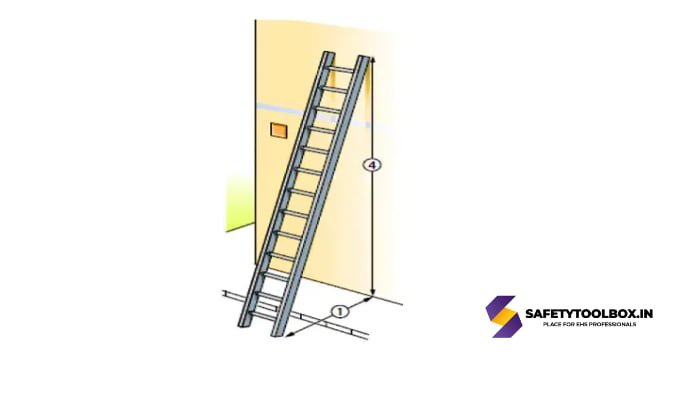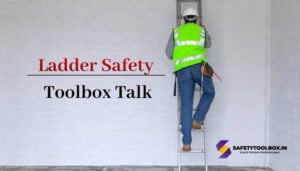Ladder Safety toolbox talk: Ladders are used for working at heights. They are also used for access egress from confined spaces, excavations, or scaffoldings. In USA 64,000 first aid injuries and 300 deaths are caused by falls from ladders in a year. In most cases, people died by fall from less than 10 feet of height. In industries, the majority of accidents related to falling from heights are because of failures of portable ladders. Ladders are classified into two categories portable ladders and fixed ladders.
Fixed ladders are fixed with structure so risks related to material failure is less in this type of ladder majority of risks which is associated with fixed ladders are relevant to the unsafe act by a person
Portable ladders are constructed by three materials such as aluminum, wooden, and glass fibers. Due to lightweight aluminum type ladders are used mostly in industries. wooden ladders are mostly used at construction sites and glass fiber ladders are used for working near electrical equipment.
Major Causes of ladder accidents
- Due to movement of ladder while in use
- Overreaching by worker
- Slipping form rungs
- Defective ladder
- ladder not secure or fixed
- Contact with electricity
Hazard of Ladder
- Fall from height due to ladder slipped, damaged
- ladder toppling from sideway
- Object falling from height

Ladder Safety Precautions
During working at height by ladder ensure following points for the safety of yourself
- Ensure right ladder should be selected as per work (straight ladder, step ladder, extension ladder, platform ladder or multipurpose ladder)
- Inspect ladder before use
- Ensure ladder inspection tag must be placed on ladder
- Don’t use any damaged or broken ladder
- Rungs of ladder must be free from crack ,bend or dent
- Side rails of ladder is in good condition
- It should be tall enough to reach at required height
- Ensure safe duty rating (safe working load) of ladder before using any ladder
- Ladder should have a label of details such as it’s size, maximum reach, serial no., duty rating, highest standing level, model number etc.
- Ensure ladder should be complied with appropriate relevant standard
- Ladder should be extend at least three feet above the point of support/ stepping off point
- 4:1 ratio should be maintained for safe working
- Overreaching is not allowed. maintain center of your body while working on ladder
- Tied ladder before step up to prevent from slipping
- Ladder should be hold by someone from bottom if provision of tied up not possible
- At a time only one person can be allowed on ladder
- 3 point contact must be followed while stepping ups or down from ladder to prevent from fall ( it can be one hand and two leg or two hand and one leg)
- Don’t hold material in hand while steping (both hand should be free)
- Use belts or ropes for carrying tools or materials on ladder
- Face should be toward ladder while climbing up and down
- Do not use ladder on uneven ground. it should be place on level floor or ground
- Use appropriate plates if ground is soft or loose
- Location of ladder must be dry and free from slip hazards (oil, chemicals etc.)
- Ensure shoes must be clean (free from slippery material) before climbing the ladder
- Ensure ladder should not be placed on window or back side of door
- Moving of ladder not allowed while someone working on it
- Do Not use I type ladder (straight ladder) for working. it is used for only climbing ups and down. for working only platform type and A type ladders (step ladder) are allowed
- Standing on top platform of step ladder (A type) not allowed
- Stand below top two rungs of step ladders
- Spreader must be locked properly in A type ladder
- Consider proximity of live electric conductor while working near power lines
- Aluminium ladder should not be allowed near live electrical supply
- Use glass fiber type ladder for working near electrical supply
- Worker must be trained for correct use of ladders and inspection of ladder
- Ensure ladder should be stored and shifted properly to avoid damages
- Ladder footing rubbers are in good condition (replaced if found damaged)
- Extension ladder locking should be in working condition
- Don’t use ladder on unsecured platform
- Never connect two ladder to reach at height
- In case of any defect remove ladder from workplace or put tag on ladder “Do not use”
- ladder should not be used in adverse weather conditions (high wind or heavy rain etc)
- Use safety helmet, safety harness, safety shoes, hand gloves while working on ladder
To find more Safety toolbox talk please click here

Safety always first..
Please send me this various toolbox talks
Sure samuel
Kindly send me this toolbox talks, please.
Please send me the various toolbox talks.
Pls share
Please send me the various toolbox talks.
There is a lot of accidents on ladders because a lot of people don’t recognize the hazard
A fall could have been averted if
1. A fall barrier is set around her at the top
2. Possible use of full body harness
Nice tips. Keep up the good work.